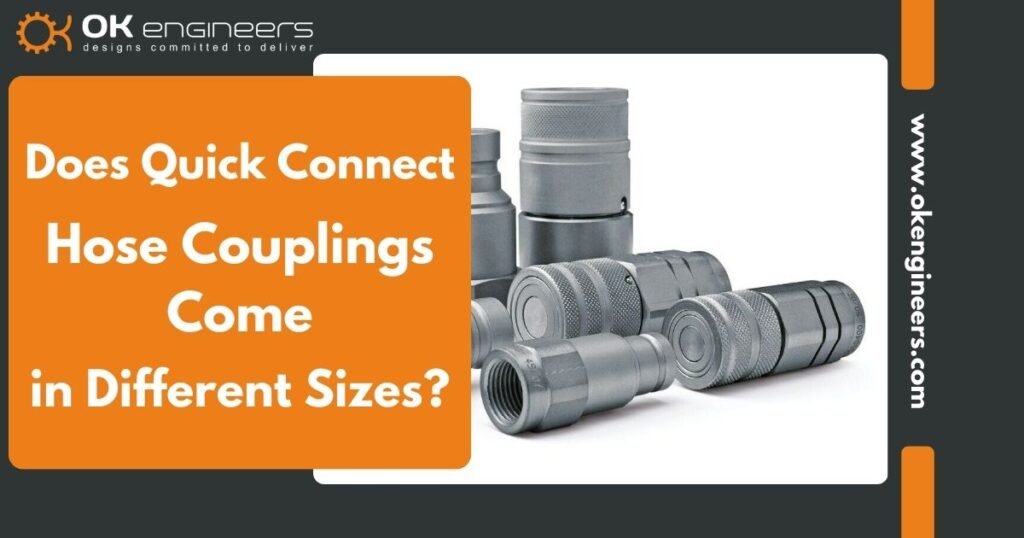Quick connect hose couplings are necessary in all kinds of industries from agriculture to automotive and manufacturing. Such a versatile hose coupling will allow the secure and leak-free connection between hoses and equipment. In short, quick connect hose couplings are not dispensable in fluid transfer systems. But a common question pops up in one’s mind that is, do quick connect hose couplings come in various sizes? The answer is an affirmative yes.
So, In this blog, we’ll explore the sizing options available for quick connect hose couplings, their applications, and how to choose the right size for your needs. We’ll also touch on key considerations such as compatibility with a hydraulic hose connector and the role of a brass couplings manufacturer in delivering high-quality solutions.
What Are Quick Connect Hose Couplings?
Quick connect hose couplings are specialised devices that permit the rapid connection and disconnection of hoses to equipment or systems without using extra tools. They have two parts:
- Plug (male part): It inserts into the socket.
- Socket (female part): It secures the connection.
These couplings are designed to handle various fluids, such as water, air, oil, and hydraulic fluids, making them widely used across industries.
Do Quick Connect Hose Couplings Come in Different Sizes?
Yes, quick connect hose couplings come in a wide range of sizes, to accommodate different hose diameters and system requirements. Common sizes are measured in inches or millimeters and include the following:
- 1/4 inch, 3/8 inch, and 1/2 inch for smaller hoses
- 3/4 inch, 1 inch, and above for larger industrial hoses.
These size differences guarantee that hose couplings can provide for the requirements of many applications, ranging from residential garden hoses to high-pressure hydraulic hose connectors on industrial machinery.
Key Sizing Issues for Hose Couplings
1. Hose Diameter: The diameter of the coupling must be equivalent to that of the hose’s inside diameter to provide a tight seal with no leaks. Always take your hose measurements before purchasing a coupling.
2. Thread Compatibility: Couplings usually come in threaded connections; thus, ensure that the type of thread is compatible with your equipment, for instance NPT or BSP.
3. Application Requirements: For high pressure systems such as hydraulic operations, bigger sizes and hard-wearing materials such as brass or stainless steel would be required. A brass couplings supplier will provide options with durability suited to your applications.
4. Flow Rate: The size of the hose coupling connector determines the flow rate of the fluid passing through the system. Larger couplings support higher flow rates, which is quite crucial in industrial applications.
Applications of Quick Connect Hose Couplings
Quick connect hose couplings are used in different applications, such as
Gardening and Landscaping: For connecting garden hoses to sprinklers or water outlets.
Automotive Industry: Used in cooling and fuel systems.
Hydraulics: Along with a hydraulic hose connector for the fluid power system.
Industrial Machinery: For hoses carrying air, water, or oil.
Material of Quick Connect Hose Couplings
The couplings material gives much strength to its sturdiness and compatibility over particular fluid. The often used coupling materials include
1. Brass
- With a tremendous durability and resists the corrosion.
- A suitable and widely used choice for use with water, as well as oil.
- Popular usage by top brass coupling manufacturers.
2. Stainless Steel
- Having great strength and resisting extreme temperature conditions.
- Ideal for high-pressure hydraulic systems.
3. Plastic
- Low weight and budget-friendly
- Perfect for low-pressure applications such as gardening.
How to Choose the Best Quick Connect Hose Coupling
In order to make the right choice, ensure that the following are taken into account when selecting a quick connect hose coupling connector:
1. Select the Hose Size: Match your hose’s inner diameter with the coupling size for proper fit.
2. Check Pressure Rating: In hydraulic applications, choose a coupling suitable for the pressure level of your system.
3. Consider the Fluid Type: Ensure the coupling material is compatible with the fluid being transported.
4. Consult a Manufacturer: Reach out to a reputable brass couplings manufacturer or supplier to ensure quality and compatibility.
Why Size Matters for Hose Couplings
Choosing the correct size for your quick connect hose couplings is crucial for:
- Preventing Leaks: A secure fit ensures a leak-free connection.
- Improves performance : Accurately sized couplings ensure optimal fluid transfer and minimise friction inside the system.
- Safety: Inaccurate sizing of couplings often makes them fail, thus posing risk to safety.
Conclusion
Quick-connect hose couplings come in a variety of sizes so that various different industries around the world can achieve their diversified demands. A garden hose connects, assembling a hydraulic system, and even contacting a brass couplings manufacturer for your desired solution might require different-sized and specific materials to succeed. By understanding the key considerations and consulting with reliable suppliers, you can be ensured that your hose coupling connector provides a secure, efficient, and long-lasting connection. Make the right choice today to maximise the performance of your system!
FAQs:
Q1. Are quick connect hose couplings compatible with all hose specifications?
No, compatibility depends upon the size, thread, and material of the coupling. Always check your hose specifications.
Q2: Can I use quick connect hose couplings with a hydraulic system?
Yes, quick connect couplings are widely used in hydraulic systems. Make sure they are compatible with your hydraulic hose connector.
Q3: What is the toughest material for hose couplings?
The most durable would be stainless steel, although brass is a very common choice due to its excellent corrosion resistance and cost-effectiveness.
Q4: How do I measure my hose to determine the correct coupling size?
Measure the inner diameter of the hose to make sure you get the right size coupling.
Q5: Are quick-connect hose couplings available in metric sizes?
Yes, most manufacturers offer couplings in both imperial and metric sizes to meet the needs of markets all over the world.



